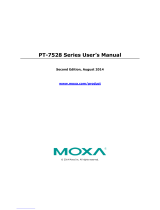
Table of Contents
1. About this Manual ................................................................................................................................. 5
2. Getting Started ..................................................................................................................................... 6
Serial Console Configuration (115200, None, 8, 1, VT100) .......................................................................... 6
Configuration by Telnet Console .............................................................................................................. 8
Configuration by Web Browser .............................................................................................................. 10
Disabling Telnet and Browser Access ...................................................................................................... 12
3. Featured Functions ............................................................................................................................. 13
Configuring Basic Settings .................................................................................................................... 13
System Identification .................................................................................................................... 13
Password..................................................................................................................................... 15
Password Login Policy ................................................................................................................... 16
Accessible IP List .......................................................................................................................... 16
Port Settings ................................................................................................................................ 17
Network Parameters ..................................................................................................................... 19
GARP Timer Parameters ................................................................................................................ 21
System Time Settings ................................................................................................................... 21
IEEE 1588 PTP ............................................................................................................................. 23
Turbo Ring DIP Switch .................................................................................................................. 28
System File Update ....................................................................................................................... 29
Restart ........................................................................................................................................ 30
Reset to Factory Default ................................................................................................................ 31
Loop Protection ................................................................................................................................... 31
Using Port Trunking ............................................................................................................................. 31
The Port Trunking Concept ............................................................................................................ 32
Port Trunking Settings .................................................................................................................. 32
Configuring SNMP ................................................................................................................................ 34
SNMP Read/Write Settings ............................................................................................................. 35
Trap Settings ............................................................................................................................... 36
Private MIB Information ................................................................................................................ 37
Using PoE (PoE Models Only) ................................................................................................................. 37
Type 1 ........................................................................................................................................ 37
Type 2 ........................................................................................................................................ 41
Using Traffic Prioritization ..................................................................................................................... 50
The Traffic Prioritization Concept .................................................................................................... 50
Configuring Traffic Prioritization ..................................................................................................... 52
Using Virtual LAN ................................................................................................................................. 56
The Virtual LAN (VLAN) Concept ..................................................................................................... 56
Sample Applications of VLANs Using Moxa Switches .......................................................................... 58
Configuring Virtual LAN ................................................................................................................. 59
QinQ Setting ................................................................................................................................ 62
VLAN Table .................................................................................................................................. 63
Using Multicast Filtering ........................................................................................................................ 63
The Concept of Multicast Filtering ................................................................................................... 63
Configuring IGMP Snooping ........................................................................................................... 67
Current Active IGMP Streams ......................................................................................................... 69
Static Multicast MAC Addresses ...................................................................................................... 70
Configuring GMRP......................................................................................................................... 71
GMRP Table ................................................................................................................................. 71
Multicast Filtering Behavior ............................................................................................................ 72
Using Bandwidth Management ............................................................................................................... 72
Configuring Bandwidth Management ............................................................................................... 72
Security .............................................................................................................................................. 76
Management Interface .................................................................................................................. 76
User Login Authentication – User Login Settings ............................................................................... 77
User Login Authentication – Auth Server Setting .............................................................................. 77
Authentication Certificate ...................................................................................................................... 78
SSL Certificate Management ................................................................................................................. 79
Using Port Access Control ..................................................................................................................... 79

























